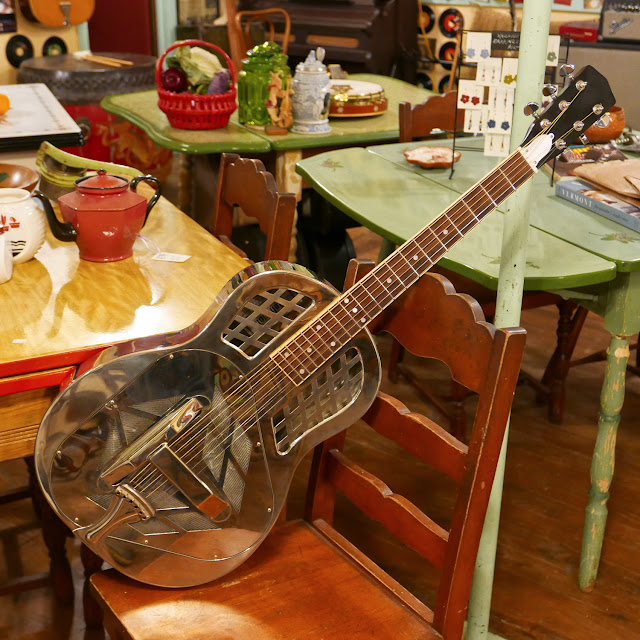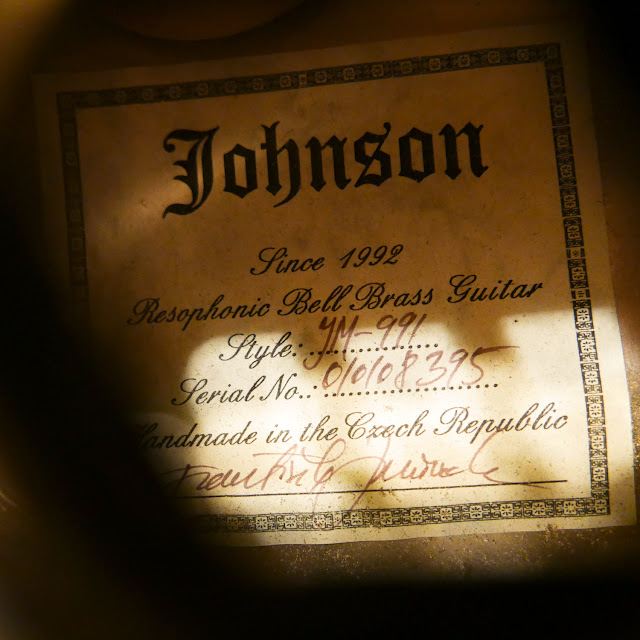2001 Amistar-made Johnson JM-991 Tricone Guitar
Update 2017: I was traded this guitar and so I've updated the description, soundclip, and pictures.
The Czech-made Amistar resonator guitars are definitely several steps above the current (and 2000s) line of Chinese-import Johnson-branded instruments that replaced this particular model. The metalwork is much nicer and the neck is, too -- though the neck's cut and quality is not on par with something like an NRP "National." It's still excellent, though, and has a bigger, C-shaped profile and flat fretboard which is still similar to the old '30s Nationals.
The Czech-made Amistar resonator guitars are definitely several steps above the current (and 2000s) line of Chinese-import Johnson-branded instruments that replaced this particular model. The metalwork is much nicer and the neck is, too -- though the neck's cut and quality is not on par with something like an NRP "National." It's still excellent, though, and has a bigger, C-shaped profile and flat fretboard which is still similar to the old '30s Nationals.
This one has no branding at the headstock and has had its cones swapped for an NRP tricone set which yields much-improved, fuller sound over the originals (Eastern European cones tend to be just a hair stiff and so they can be a bit thwacky).
When I first saw this guitar in 2016 I knew it needed the "usual used resonator" work -- and it got it, this time around. I reset the neck (which is just as arduous as on a flattop), leveled and dressed the frets, tidied-up the seating of the National replacement cones in the soundwell, added a duct-tape "gasket" anywhere I could see that metal-on-metal might rattle, added a retaining bolt for the dowel near the neck joint, adjusted the bridge placement so I could compensate the saddle correctly, made a new, compensated bone saddle insert for the bridge, replaced a too-small replacement truss rod cover, added National-style strap buttons, cleaned it up, and set it up with 54w-12 strings.
It's playing spot-on with 3/32" bass and 1/16" treble action at the 12th fret and has a straight neck. The tone is full, round, and punchy. I think of a good tricone like this as a great alternative for people who like the mellower lower-mids, sustain, and sweeter highs of a Dobro, want much of the bite of a good biscuit-cone National, but don't want the zippy/sometimes shrill high end of the usual biscuit cone. In other words -- these make good all-arounders and this thing is loud as heck.
When I first saw this guitar in 2016 I knew it needed the "usual used resonator" work -- and it got it, this time around. I reset the neck (which is just as arduous as on a flattop), leveled and dressed the frets, tidied-up the seating of the National replacement cones in the soundwell, added a duct-tape "gasket" anywhere I could see that metal-on-metal might rattle, added a retaining bolt for the dowel near the neck joint, adjusted the bridge placement so I could compensate the saddle correctly, made a new, compensated bone saddle insert for the bridge, replaced a too-small replacement truss rod cover, added National-style strap buttons, cleaned it up, and set it up with 54w-12 strings.
It's playing spot-on with 3/32" bass and 1/16" treble action at the 12th fret and has a straight neck. The tone is full, round, and punchy. I think of a good tricone like this as a great alternative for people who like the mellower lower-mids, sustain, and sweeter highs of a Dobro, want much of the bite of a good biscuit-cone National, but don't want the zippy/sometimes shrill high end of the usual biscuit cone. In other words -- these make good all-arounders and this thing is loud as heck.
It's also a looker -- though it does have some average wear to it. There's a very minor amount of light scratching here and there and some minor corrosion/aging to the nickel-silver plating throughout, but it's in pretty good shape for a guitar that was played a bit.
This has a 1 11/16" nut width but it feels more like 1 3/4" with the medium, C-shaped neck profile and flat board. The truss rod cover is my own parts-bin add-on and I think it gives a more retro look than the funky, replacement black one that was on here when it came in.
The board is rosewood and the neck is mahogany and this has a 25 1/2" scale which puts plenty of tension on the cones.
The board is rosewood and the neck is mahogany and this has a 25 1/2" scale which puts plenty of tension on the cones.
The frets are medium stock and they've been leveled down some, but still have a good amount of life left. The board is rosewood and has cream binding. The dots were originally faux-pearl but during the neck reset I had to remove 6 of them at the fretboard extension to get the neck off, so I replaced the whole lot of them with actual pearl this time around.
Isn't that work around the soundholes great? The cut of the body is superlative compared to much of the stuff coming out these days.
The coverplate is nice and authentic and looks excellent.
Even though I have a pretty tall saddle on this guitar after the neck reset, I still like to string the tailpiece with the strings "under" it to add more back angle and allow some string-afterlength muting foam to be shoved under the lip of it to damp overtones.
The Grovers work just dandy.
Aside from adjusting the blocking of the "islands" or "soundposts" that support the dowel that runs through the guitar, I also added a "retainer bolt" at the heel. All metal-bodied resonator guitars should have one of these but the only guys smart enough to install them are (surprise, surprise!) the originators of the style -- the Dopyera brothers (Dobro) -- who started adding them to builds in the '60s and through the '90s on OMI Dobros.
Just like those Dobros, my bolt runs through a spacer block and then into the meat of the dowel. This keeps the neck/heel area tight and solid to the body so that those uncomfortable moments of finding your action a mile high and the neck angle really off to one side or the other won't happen unless you want them to.
A good hard case comes with it.





















Comments